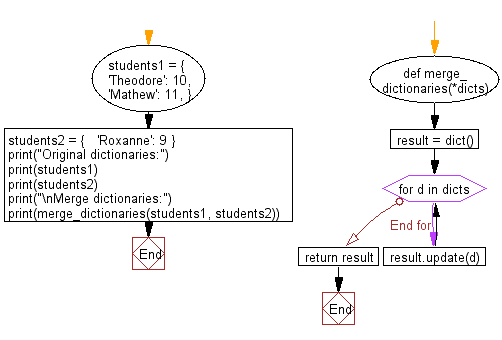Python: Merge two Python dictionaries
Python dictionary: Exercise-8 with Solution
Write a Python script to merge two Python dictionaries.
Sample Solution-1:
Python Code:
d1 = {'a': 100, 'b': 200}
d2 = {'x': 300, 'y': 200}
d = d1.copy()
d.update(d2)
print(d)
Sample Output:
{'x': 300, 'y': 200, 'a': 100, 'b': 200}
Visualize Python code execution:
The following tool visualize what the computer is doing step-by-step as it executes the said program:
Sample Solution-2:
Create a new dict and loop over dicts, using dictionary.update() to add the key-value pairs from each one to the result.
Python Code:
def merge_dictionaries(*dicts):
result = dict()
for d in dicts:
result.update(d)
return result
students1 = {
'Theodore': 10,
'Mathew': 11,
}
students2 = {
'Roxanne': 9
}
print("Original dictionaries:")
print(students1)
print(students2)
print("\nMerge dictionaries:")
print(merge_dictionaries(students1, students2))
Sample Output:
Original dictionaries:
{'Theodore': 10, 'Mathew': 11}
{'Roxanne': 9}
Merge dictionaries:
{'Theodore': 10, 'Mathew': 11, 'Roxanne': 9}
Flowchart:

Visualize Python code execution:
The following tool visualize what the computer is doing step-by-step as it executes the said program:
Python Code Editor:
Have another way to solve this solution? Contribute your code (and comments) through Disqus.
Previous: Write a Python script to print a dictionary where the keys are numbers between 1 and 15 (both included) and the values are square of keys.
Next: Write a Python program to iterate over dictionaries using for loops.
What is the difficulty level of this exercise?
Test your Programming skills with w3resource's quiz.
Python: Tips of the Day
Find current directory and file's directory:
To get the full path to the directory a Python file is contained in, write this in that file:
import os dir_path = os.path.dirname(os.path.realpath(__file__))
(Note that the incantation above won't work if you've already used os.chdir() to change your current working directory, since the value of the __file__ constant is relative to the current working directory and is not changed by an os.chdir() call.)
To get the current working directory use
import os cwd = os.getcwd()
Documentation references for the modules, constants and functions used above:
- The os and os.path modules.
- The __file__ constant
- os.path.realpath(path) (returns "the canonical path of the specified filename, eliminating any symbolic links encountered in the path")
- os.path.dirname(path) (returns "the directory name of pathname path")
- os.getcwd() (returns "a string representing the current working directory")
- os.chdir(path) ("change the current working directory to path")
Ref: https://bit.ly/3fy0R6m
- New Content published on w3resource:
- HTML-CSS Practical: Exercises, Practice, Solution
- Java Regular Expression: Exercises, Practice, Solution
- Scala Programming Exercises, Practice, Solution
- Python Itertools exercises
- Python Numpy exercises
- Python GeoPy Package exercises
- Python Pandas exercises
- Python nltk exercises
- Python BeautifulSoup exercises
- Form Template
- Composer - PHP Package Manager
- PHPUnit - PHP Testing
- Laravel - PHP Framework
- Angular - JavaScript Framework
- Vue - JavaScript Framework
- Jest - JavaScript Testing Framework
